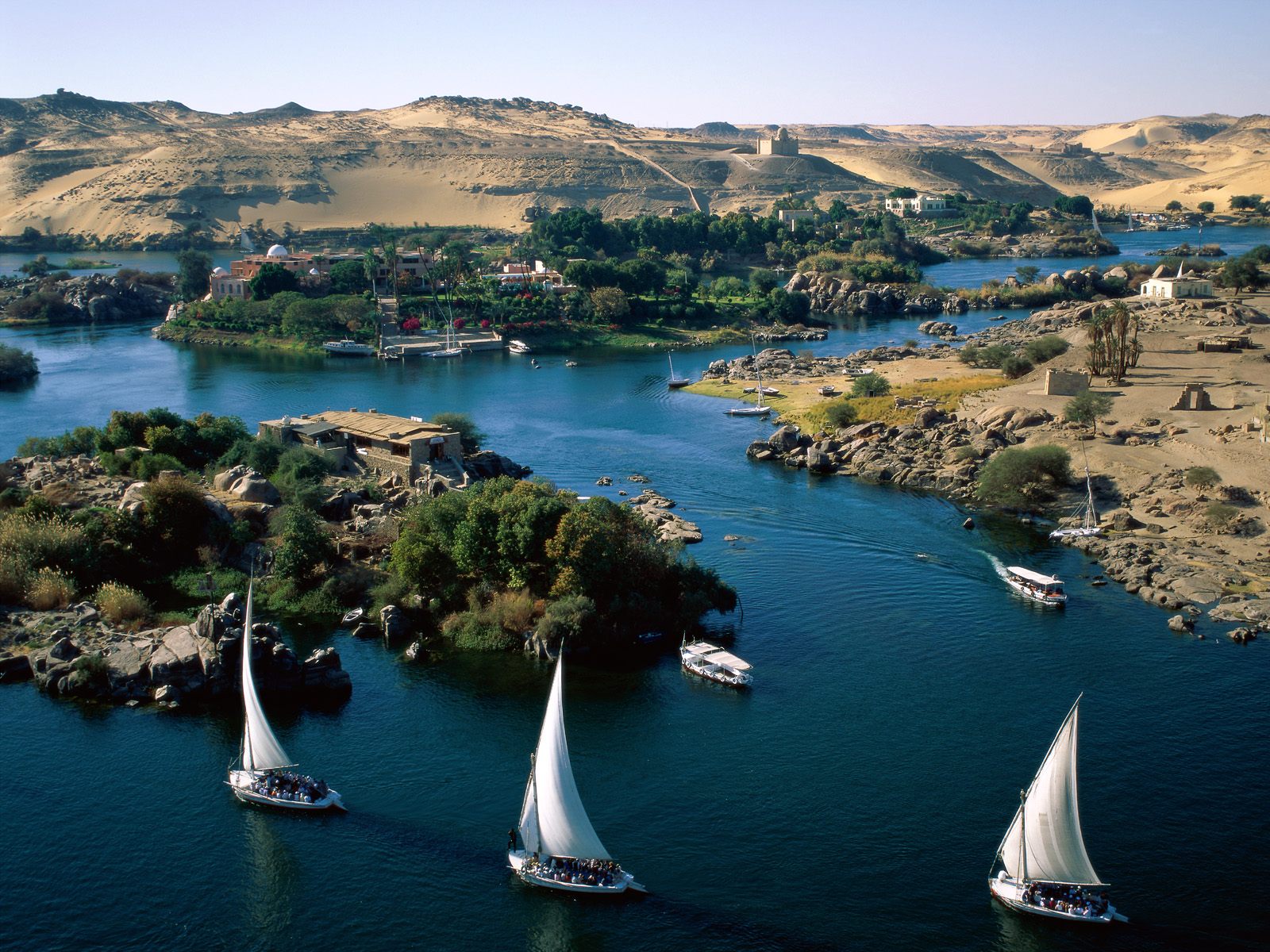Aswan, Egypt's sunniest southern city and ancient frontier town located about 81 miles south of Luxor, has a distinctively African atmosphere.
Its ancient Egyptian name was Syene. Small enough to walk around and graced with the most beautiful setting on the Nile,
the pace of life is slow and relaxing. Days can be spent strolling up and down the broad Corniche watching the sailboats etch
the sky with their tall masts or sitting in floating restaurants listening to Nubian music and eating freshly caught fish.
In Aswan the Nile is at its most beautiful, flowing through amber desert and granite rocks, round emerald islands covered in
palm groves and tropical plants. Explore the souk, full of the scent and color of spices, perfumes, scarves and baskets.
View the spectacular sunsets while having tea on the terrace of the OldCataract Hotel (Named due to the location of the
Nile's first cataract located here). Aswan has been a favorite winter resort since the beginning of the nineteenth century,
and it's still a perfect place to get away from it all.
Every night Nubian dancers and musicians perform in the Cultural Center, just off the Corniche. Folklore troupes recreate
scenes from village life and perform the famous Nubian mock stick-fight dances.
2- Day tour: Philae Temple Complex
3- Day tour: Kom-Ombo Temple Complex
4- Day tour: Nubian Museum
5- Tour to Edfu Temple
6- A felucca trip
7- Guided Tour : Aswan Market

On Lake Nasser - 175 miles s. of Aswan/25 miles from Sudan border, Aswan,
Egypt Abu Simbel is an archaeological site comprising two massive rock temples in southern Egypt along the Nile about 290 km
southwest of Aswan. It is part of the UNESCO World Heritage Site of "Nubian Monuments" which run from Abu Simbel downriver to Philae.
The Great Temple of Ramses II at Abu Simbel consists of four seated colossal statues of Ramses II carved into the mountain,
forming one of the boldest temple facades in the world. It is aligned so the sun's rays travel through the mountain and illuminate
Ramses' sanctuary twice a year -- on October 22 a nd February 22, Ramses II was a 19th dynasty pharaoh of Egypt. He ruled for 67 years
during the 13th century BC, the apogee of Ancient Egypt's power and glory. This extraordinarily long reign,
the wealth available in the state coffers, and, undeniably, the pharaoh's personal vanity meant that Ramses,
of all the ancient rulers, left what is perhaps the most indelible mark on the country. His legacy can be seen
most clearly in the archaeological record – in the many buildings that Ramses modified, usurped, or constructed from the ground up.
Construction of the temple complex started in approximately 1284 BC and lasted for about 20 years.
Known as the "Temple of Ramesses, beloved by Amun", it was one of six rock temples erected in Nubia during the long reign of Ramesses.
Their purpose was to impress Egypt's southern neighbors, and also to reinforce the status of Egyptian religion in the region.
Travel Resources: Day tour "Aswan-Abu Simble-Aswan by A/C bus-
- Day tour "Aswan-Abu Simble-Aswan by plane
- Nile Cruise Journey from Aswan to Abu Simble
Day tour: Philae Temple Complex

Philae Temple was dismantled and reassembled (on Agilika Island about 550 meters from its original home on Philae Island) in the wake
of the High Dam. The temple, dedicated to the goddess Isis, is in a beautiful setting which has been landscaped to match its original site.
It's various shrines and sanctuaries, which include The Vestibule of Nectanebos I which is used as the entrance to the island,
the Temple of the Emperor Hadrian, a Temple of Hathor, Trajan's Kiosk (Pharaohs Bed), a birth house and two pylons
celebrate all the deities involved in the Isis and Osirismyth. The Victorian world fell in love with the romance of the Temple.
But at night you can also visit the Sound and Light Show, a magical experience as floodlit buildings are silhouetted
against the volcanic rocks and water surrounding them. So today, Philae is more fun then every before.
Although antiquities on the island date between the 26th Dynasty and the Roman Period, most of the work is from that of the Roman.
This was a time of immense popularity of the Goddess Isis, and this was her island, where pilgrims would come from all over the Mediterranean.
Construction on the island took place over an 800 year span, and it was one of the last strongholds of Ancient Egyptian
Religion which continued to flourish here into the 6th Century. When the Temples where finally closed by Justinian in A.D 550,
t ended 4,000 years of worship of the pagan gods.
The Philae Temple complex, prior to its removal and restoration, set alongside Biga Island. To the ancient Egyptians,
Biga was the sacred mound, the first ground created from Nun out of Chaos. This was the legendary burial place of Osiris.
The earth was considered to be part of his body so that only priests and temple servants were permitted to live there.
Day tour: Kom-Ombo Temple Complex

While the stone differs from that of all the other temples perhaps because it was covered with sand for so long, the outstanding
feature of the Kom Ombo Temple is the unusual, even unique, ground plan, the result of the unification of two adjacent temples,
each dedicated to a distinct divinity: the crocodile-headed Sobek, god of fertility and creator of the world, and Haroeris or the
ancient falcon-headed Horus, the solar war god.
This was why the temple was called both "House of the Crocodile" and "Castle of the Falcon". An imaginary line divides the
temple longitudinally into two parts, each with its entrance, hypostyle halls, chapels, etc. The right part of the temple was
consecrated to Sobek, the left to Haroeris, whose winged disk that protects from all evils is depicted over all the entrance portals.
This temple, too, was the work of the Ptolemies who built it on the site of a much older and smaller sanctuary of which little remains.
All that is left of the great entrance pylon is the right hand part, where the Roman emperor Domitian can be seen with various gods
rendering homage to the triad of Sobek, Hathor and Khonsu, together with a long text of 52 lines in hieroglyphics.
The court that follows must originally have been quite lovely, with its sixteen painted columns on three sides. Now only the base
and the lower part are left, with, at the center, the remains of the altar on which the sacred bark was placed during processions.
The reliefs on the columns show the emperor Tiberius, whose name is cut into the cartouches which accompany the figures,
as he makes offering to the gods. The north part of the court is closed by the exterior wall of the pronaos, or first hypostyle hall.
The two entrances that correspond to the temples of Haroeris and of Sobek open in this wall. On either side of the doors,
Ptolemy XII Neo Dionysos is shown purified by Horus, Thot and Haroeris (in the part on the left) and by Horus, Thot and Sobek on the right.
The first hypostyle hall has three transversal rows of fine bundle columns each with a bill capital. Some of them are lotus-shaped,
others papyrus, and one is even palm-shaped. The ceiling is decorated with astronomical scenes, with the vulture, t
he symbol of Nekhbet and Uadjit. The column shafts are all carved with reliefs: above, under the capitals,
with a band of hieroglyphs with the symbol of life (ankh) and below with the pharaoh rendering homage to the various gods.
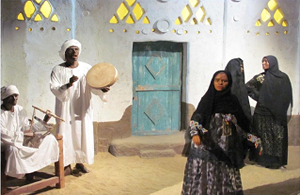
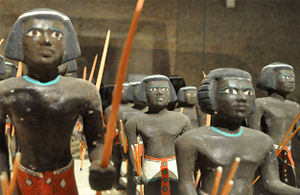
In the early 1960's, when Egypt built the High Dam at Aswan, Egyptologists and archaeologists the world over heeded
UNESCO's appeal to salvage the monuments of Egyptian Nubia before the rising waters of Lake Nasser submerged them forever.
More than sixty expeditions ultimately joined the "Nubian Rescue Campaign", which resulted in the excavation and recording of hundreds of sites,
the recovery of thousands of objects, and the salvage and translocation of a number of important temples to higher ground.
Due to the quantities of material recovered from tombs, temples and settlements, UNESCO was encouraged in the 1980's
to plan a new Nubian museum in Aswan where the objects could be stored and exhibited. It was universally felt at the time
that they should be kept as close as possible to their principal places of origin.
Nearly twelve years later, the Museum became a reality and opened its doors in November 1997. It was designed by the
late Egyptian architect Mahmoud al-Hakim, and Mexican architect Pedro Vasquez Ramirez designed the museum's interior display.
The Museum won the Agha-Khan Award of Architecture 2001.
The total area of the complex is 50,000 square meters: 7,000 allocated for the building, and 43,000 for the grounds.
The architecture of the Museum and the enclosure walls are intended to evoke traditional Nubian village architecture,
as it was along the Nubian Nile before the region was flooded by Lake Nasser.
The building is set within a landscape, on graded levels, that includes a sequence of waterfalls. When the waterway reaches
the lower part of the garden, it divides into 2 branches to surround an open-air stage and amphitheater where already
many local and foreign groups have performed. The remaining 43,000 sq. m. have been planted with palm trees,
flowers, and climbing plants, spread over natural rocks. An outdoor exhibit is planned for the garden,
but at the moment only a small section is ready. The project is a beautiful resolution of a long-awaited dream.
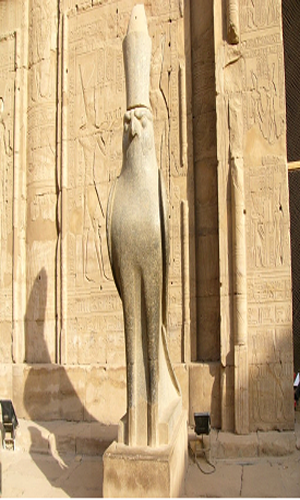
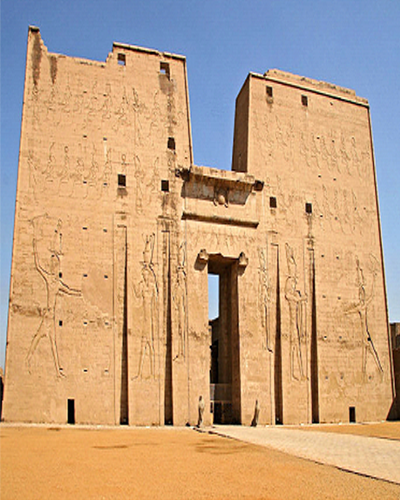
Dedicated to Horus, the falcon headed god, it was built during the reigns of six Ptolemies.
We have a great deal of information about its construction from reliefs on outer areas.
It was begun in 237 BC by Ptolemy III Euergetes I and was finished in 57 BC.
Most of the work continued throughout this period with a brief interlude of 20 years while there was
unrest during the period of Ptolemy IV and Ptolemy V Epiphanes.
This is not only the best preserved ancient temple in
It was believed that the temple was built on the site of the great battle between Horus and Seth.
Hence, the current temple was but the last in a long series of temples build on this location.
It is said that the original structure housing a statue of Horus was a grass hut built in prehistoric times.
At any rate, there is an earlier and smaller pylon of Ramesses II which sits in a 90 degree angle to the current building.
The main building, which includes a great Hypostyle Hall, was uncovered by Mariette in the 1860s.
There are numerous reliefs, including a depiction of the Feast of the Beautiful Meeting,
the annual reunion between Horus and his wife Hathor. The reliefs are mostly situated on the inside of the first pylon,
and spiritually connect this temple with Hathor’s
During the third month of summer, the priests at the Dendera complex would place the statue
of Hathor on her barque (a ceremonial barge) and would thus bring the statue to the
where it was believed that Horus and Hathor shared a conjugal visit. Each night,
the god and goddess would retire to the mamissi, or berthing house. There is still an entrance colonnade
to the mamissi, and reliefs with considerable remaining color just outside the main temple.
These images portray the ritual of the birth of Harsomtus, son of Horus and Hathor.
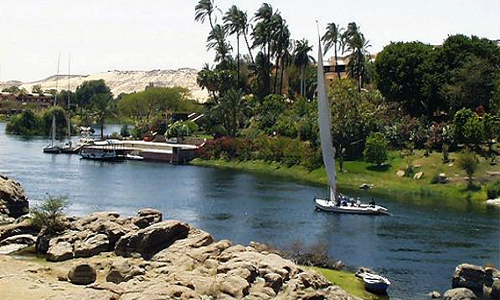
is a must at Aswan, and pleasure and convenience can be combined if you heading
out for sights on the other side of the Nile.
![]() A felucca is a local sail boat, which benefits from the winds on the Nile, and whenever possible,
A felucca is a local sail boat, which benefits from the winds on the Nile, and whenever possible,
also the streams.
![]() Felucca trips are great ways of cooling off in the afternoon, while being on an open boat in the midday sun
Felucca trips are great ways of cooling off in the afternoon, while being on an open boat in the midday sun
may be too much for many. While out with the felucca there is nothing stopping you from enjoing food you bring with you
(it is good courtesy to share with the felucca captain) or take a swim in the Nile.
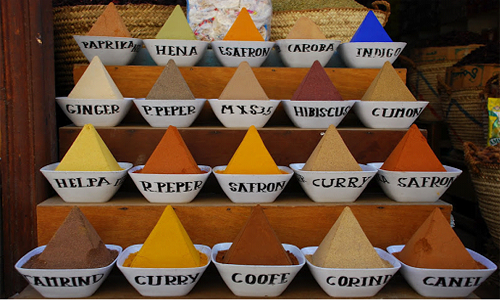
is located near the Nile river valley and offering you a unique pleasure to shop in Aswan .
It is a heaven for all those who have come to shop from the different parts of the world where fruits , spices ,
vegetables and handicrafts mix in a dazzling lively symphony . Among the products you will find available are products
of leather , textile , typical Nubian (related to Nubia region) dresses and also objects , collars , bracelets , books and music .
Side by side , you can be taken by the Karkade (Hibiscus Sabdariffa) and other many colorful spices and herbs which have unique appreciable odors .
To spend a good time , there are various marvelous things to do . You can enjoy drinking tea ,
or smoking Shisha (the Egyptian water-pipe or Hookah) while listening to the Nubian music or listening to Om Kolthoum ,
who is –though deceased more than 20 years ago– the most famous and favorite Egyptian singer .
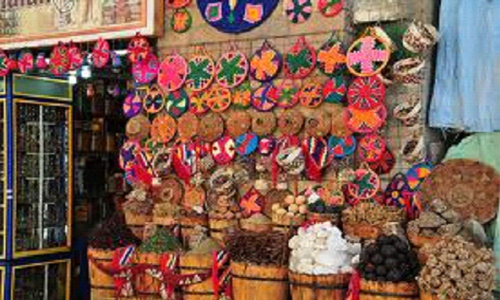
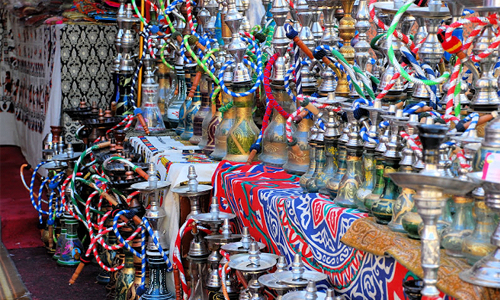
Select Your Language
Designed & Developed by itQan for Web Design


